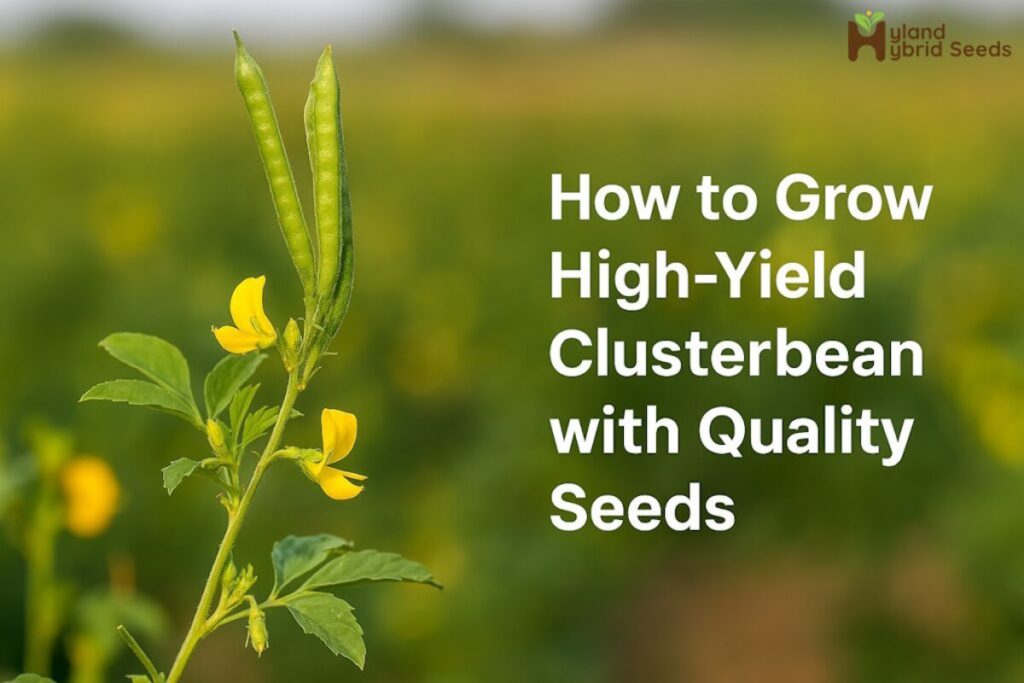How to Grow High-Yield Clusterbean with Quality Seeds

Clusterbean, widely known as guar, is a key crop for farmers across arid and semi-arid regions. It’s not just valued for its drought tolerance but also for its multiple uses—from producing guar gum for industrial applications to serving as a nutritious fodder for livestock.
But here’s the deal: if you want a bumper harvest, everything starts with quality clusterbean seeds. Choosing the right seeds isn’t just about germination; it impacts plant health, resistance to pests, and overall yield. Working with a reliable clusterbean seeds supplier can help you avoid losses and give your crop the strong start it needs.
This guide walks you through the process of selecting the right seeds, preparing your field, and managing your crop for higher productivity.
Start your farming journey with quality seeds.
Why Seed Quality Matters in Clusterbean Farming
Many farmers underestimate the role of seed quality in crop success. Using substandard seeds often leads to:
- Poor germination rates.
- Stunted plant growth.
- Higher vulnerability to pests and diseases.
- Uneven crop maturity.
On the other hand, certified seeds from a trusted clusterbean seeds supplier ensure:
- Uniform germination across the field.
- Vigorous plants with higher pod setting.
- Resistance to common diseases like blight and mildew.
- Better gum content for higher market value.
If you want to avoid re-sowing or patchy fields, start with seeds you can trust.
How to Select the Right Clusterbean Seeds
Here’s a checklist to help you choose seeds wisely:
1. Go for Certified Seeds
Certified seeds meet purity and germination standards set by agricultural boards. Always ask for certification proof when sourcing.
2. Pick the Right Variety
Choose varieties suited to your climate and purpose:
- RGC-936: High gum content and drought resistance.
- HG-563: Early maturing, ideal for short growing windows.
- Pusa Navbahar: Good for rainfed conditions.
3. Check Germination Percentage
The minimum germination rate for good clusterbean seeds is 80%. Anything lower will lead to gaps in your field.
4. Buy From a Reputed Supplier
A reliable clusterbean seeds supplier offers not just seeds but guidance on sowing and crop management. Avoid unverified local markets where seed quality often varies.
Ideal Growing Conditions for Clusterbean
Clusterbean thrives in areas with hot and dry weather. Here’s what it needs:
- Soil: Sandy loam soil with good drainage and a pH between 7–8.5. Avoid waterlogged fields.
- Climate: Warm temperatures with moderate rainfall. Clusterbean is hardy but performs better with proper moisture during critical stages.
- Water: While drought-tolerant, timely irrigation can double your yield.
Not sure which variety suits your soil?
Step-by-Step Guide to Grow High-Yield Clusterbean
1. Land Preparation
Prepare the land thoroughly for a fine tilth.
- Plow 2–3 times to loosen soil.
- Apply well-rotted farmyard manure (8–10 tons per hectare) for better soil health.
2. Seed Treatment
Treat seeds before sowing to improve germination and protect against seed-borne diseases:
- Use Rhizobium culture for better nitrogen fixation.
- Apply fungicide like Thiram or Carbendazim @2g/kg seed.
3. Sowing Guidelines
- Time: Early monsoon (June–July) for rainfed areas or Feb–March for irrigated regions.
- Spacing: 30 cm between rows and 10 cm between plants.
- Seed Rate: 10–12 kg per hectare.
4. Fertilizer Application
Clusterbean enriches the soil with nitrogen, but initial fertilizers help.
- Apply 20 kg nitrogen and 50 kg phosphorus per hectare as basal dose.
5. Irrigation
- Give 1st irrigation 20–25 days after sowing.
- Provide water during flowering and pod formation for maximum yield.
- Avoid excess water to prevent root rot.
6. Weed Management
- Keep the field weed-free for the first 30–40 days.
- Two hoeings at 15-day intervals are usually sufficient.
7. Pest and Disease Control
- Pests: Control aphids and jassids using neem oil or recommended insecticides.
- Diseases: Rotate crops to prevent blight and mildew. Choose resistant varieties.
Harvesting and Post-Harvest Practices
- Harvest when pods turn brown and dry.
- Avoid delay, as overripe pods shatter easily.
- Sun-dry seeds for 2–3 days before storage.
- Store seeds in airtight containers in a cool, dry place to maintain viability.
Tips to Boost Clusterbean Yield
- Always source seeds from a certified clusterbean seeds supplier.
- Avoid waterlogging and ensure proper drainage.
- Provide timely irrigation at flowering and pod development.
- Use pest-resistant varieties to minimize crop loss.
Why Work With a Certified Seeds Supplier?
A reputable supplier provides:
- High germination seeds for uniform growth.
- Disease-free varieties tested in similar climates.
- Expert advice on best practices for your region.
This partnership helps you avoid risks and improve returns.
Ready to Grow a Profitable Clusterbean Crop?
A successful crop begins with quality inputs. Start by sourcing clusterbean seeds from a trusted supplier and follow smart farming practices for a productive season.
Partner with a trusted supplier for better results.
FAQs
How do I select the best clusterbean seeds?
Choose certified seeds with a germination rate above 80% from a reliable supplier.
What is the ideal time for sowing clusterbean?
Early monsoon (June–July) in rainfed regions and February–March in irrigated areas.
Why should I treat clusterbean seeds before sowing?
Seed treatment boosts germination and protects against diseases.
Can clusterbean grow in poor soil?
Yes, it tolerates poor soils but performs better in sandy loam with good drainage.
Where can I find a reliable clusterbean seeds supplier?
Work with certified suppliers who offer tested and region-appropriate varieties.
